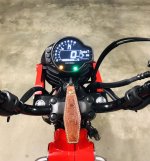 My thoughts on running the Opmid meter and centring bracket for a hundred km or so:
My thoughts on running the Opmid meter and centring bracket for a hundred km or so:overall, a more fiddly install than I expected but well worth the effort and expense. I posted my initial thoughts onto another thread in the Tech section but thought I’d start a dedicated thread to do with the bracket specifically. The install of the meter itself has been well covered by others (make sure you watch Spydie’s vid) and the manufacturer’s instructions are very thorough, so I won’t go into detail there.
I found no info on the bracket itself, other than a vague photo suggesting cutting of the original bracket and retro fitting the new centring bracket above it. After commencing the install, I discovered that the original off-centre bracket can be completely removed intact without major difficulty with the only potential problem being the loss of the 12v socket mount. I wasn’t using mine, so no loss there. Here are my own tips if you’re interested in doing this yourself:
*The new centring bracket comes in a plain metal finish but is simple to rattle can/powder coat/plastidip black prior to install.
*The two rubber mounting grommets will need to be removed from the original bracket & reused on the new one.
*The electric cables and brake hose are straightforward to unclip from the old bracket
*The electrical connectors need to be resecured safely to the inside of the headlight bracket (zip ties to the rescue)
*The throttle cables required some minor, easily reversible bending of the capturing bracketry to release
* Low strength threadlocker is suggested when reusing the Allen bolts to fasten the new bracket.
*This should be a completely reversible mod, should you wish to reinstall the original instrument again if you sell the bike or, heaven forbid, bust the Opmid unit.
*The display screen is easily scratched. Opmid also sell a two pack of screen protectors, which I bought and wish I had have installed before I started fitting the meter itself. Oops.
*Note that this procedure has been performed on an Australian CT125, which we think is more similar to the Thai/Indo models and the North American model may not be absolutely identical in its bracketry and/or wiring connections. Please let us know if you find anything different to that described!
The old bracketectomy:

My own feelings after testing the new meter are very positive. It gives a lot more info far more clearly than the stock meter, is better illuminated and better positioned in a more traditional way. It seems to be a brilliant combination of providing higher quality info to the rider in a cleaner, less cluttered way, if that appeals to you. The bracket itself effectively becomes invisible from the riding position and also allows a more appealing view of that nicely fluted headlight shell, as well as the road flashing by below the headlight brackets. My only cons are that the gear position indicator is imprecise at low speeds or standstill (at least the neutral indicator is still foolproof and it certainly helps to confirm you’ve reached 4th gear at a mere glance at speed) and I’d also love it if the individual green arrows worked to indicate if left or right blinkers were operating but that’s a very minor nit pick. The redline/shift reminder lighting is fully customisable and the oil temp has several algorithms from which to choose so you don’t get unnecessary warnings. The oil temps seem to sit between 85-95 degrees C, which is roughly equivalent to our modern car’s gauge readings on the open road with its much better cooling system.
Last edited:
